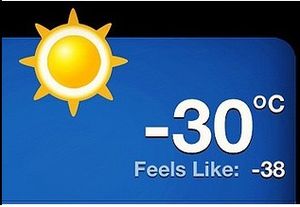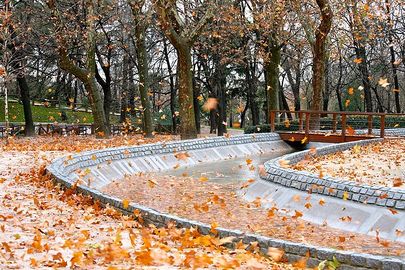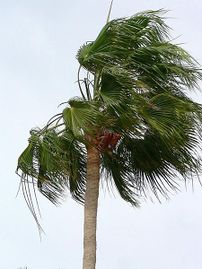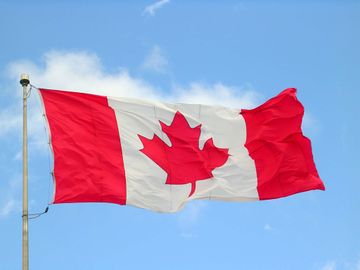Wind chill: Difference between revisions
J.williams (talk | contribs) m (1 revision imported) |
energy>Jmdonev No edit summary |
||
| Line 1: | Line 1: | ||
[[Category:Done | [[Category:Done 2018-08-03]] | ||
[[File:Windchill.jpeg|thumb|300px|Figure 1: Wind chill is often included in weather reports. Although it may be a certain exact temperature outdoors, humans feel it to be cooler as wind speeds get higher. ]] | [[File:Windchill.jpeg|thumb|300px|Figure 1: Wind chill is often included in weather reports. Although it may be a certain exact temperature outdoors, humans feel it to be cooler as wind speeds get higher.<ref name=pic>''Created internally by a member of the Energy Education team''</ref>]] | ||
<onlyinclude>Anyone who has experienced a cold winter has most likely experienced the phenomena of '''wind chill'''. Wind chill is the sensation that is caused by the combined effect of [[temperature]] and [[wind]], and in turn makes cool temperatures feel much colder.</onlyinclude> This happens because the wind | <onlyinclude>Anyone who has experienced a cold winter has most likely experienced the phenomena of '''wind chill'''. Wind chill is the sensation that is caused by the combined effect of [[temperature]] and [[wind]], and in turn makes cool temperatures feel much colder.</onlyinclude> This happens because the wind removes a layer of heat that the body creates over the skin, called the ''boundary layer''.<ref name=evoc>Environment Canada. (March 22, 2015). ''Wind chill - the chilling facts'' [Online]. Available: http://www.ec.gc.ca/meteo-weather/default.asp?lang=En&n=5FBF816A-1#table1</ref> This causes the body to lose [[heat]] faster because it's attempting to replenish this boundary layer. Wind also makes people feel colder by evaporating any moisture on their skin—a process that draws more heat away from their body.<ref name=evoc/> | ||
==Windchill Index== | ==Windchill Index== | ||
The system designed to calculate wind chill is based off of a mathematical model created by Environment Canada, and tested in Toronto, Ontario.<ref name=cbc>CBC News, ''The science of wind chill'' [Online], Available: http://www.cbc.ca/m/touch/canada/story/1.819530</ref> It uses data based off of 12 volunteers who went through clinical trials in a refrigerated wind tunnel to see how the model held up in a real-world situation. The results of the testing helped create the official index for wind chill, displayed in | The system designed to calculate wind chill is based off of a mathematical model created by Environment Canada, and tested in Toronto, Ontario.<ref name=cbc>CBC News, ''The science of wind chill'' [Online], Available: http://www.cbc.ca/m/touch/canada/story/1.819530</ref> It uses data based off of 12 volunteers who went through clinical trials in a refrigerated wind tunnel to see how the model held up in a real-world situation. The results of the testing helped create the official index for wind chill, displayed in the table below.<ref name=chart>Health Protection Department. (March 22, 2015). ''New Windchill Index'' [Online]. Available: https://www.elginhealth.on.ca/downloads/BIYBKNST.pdf</ref> | ||
<gallery caption="Wind speed references" mode=packed heights=180px> | <gallery caption="Wind speed references" mode=packed heights=180px> | ||
| Line 14: | Line 14: | ||
</gallery> | </gallery> | ||
The index below was developed by Environment Canada to determine different temperatures at certain wind speeds. Refer to the wind speed reference images above to visualize what the speeds might look like outdoors.<ref>Adapted from Environment Canada's chart available here: Environment Canada. (March 22, 2015). ''Wind chill - the chilling facts'' [Online]. Available: http://www.ec.gc.ca/meteo-weather/default.asp?lang=En&n=5FBF816A-1#table1</ref> | |||
{| class="wikitable" style="margin-left: auto; margin-right: auto; border: none;" | |||
|+ style="text-align: center;" | Table 1. Wind chill at particular wind speed and temperatures | |||
|- | |||
| 0 kph||0°C||-5°C||-10°C||-15°C||-20°C||-25°C||-30°C||-35°C||-40°C||-45°C||-50°C | |||
|- | |||
| 10 kph||-3°C||-9°C||-15°C||-21°C||27°C||-33°C||-39°C||-45°C||-51°C||-57°C||-63°C | |||
|- | |||
| 20 kph||-5°C||-12°C||-18°C||-24°C||-30°C||-37°C||-43°C||-49°C||-56°C||-62°C||-68°C | |||
|- | |||
| 30 kph||-6°C||-13°C||-20°C||-26°C||-33°C||-39°C||-45°C||-52°C||-59°C||-65°C||-72°C | |||
|- | |||
| 40 kph||-7°C||-14°C||-21°C||-27°C||-34°C||-41°C||-48°C||-54°C||-61°C||-68°C||-74°C | |||
|- | |||
| 50 kph||-8°C||-15°C||-22°C||-29°C||-35°C||-42°C||-49°C||-56°C||-63°C||-69°C||-76°C | |||
|- | |||
| 60 kph||-9°C||-16°C||-23°C||-30°C||-36°C||-43°C||-50°C||-57°C||-64°C||-71°C||-78°C | |||
|- | |||
|} | |||
* -25°C, frostbite occurs during a prolonged exposure | Although this index may seem like it's just for convenience, it is really much more than that. This information is crucial for peoples' ''safety''. It can inform people to wear more protective layers, and how to dress in cold, windy situations. Most importantly, it tells people when they are in danger of frostbite. At wind chill temperatures below: | ||
* -35°C, frostbite occurs in under 10 minutes to exposed skin | |||
* -25°C, frostbite occurs during a prolonged exposure. | |||
* -35°C, frostbite occurs in under 10 minutes to exposed skin. | |||
* -60°C, frostbite occurs in under 2 minutes to exposed skin.<ref name=chart/> | * -60°C, frostbite occurs in under 2 minutes to exposed skin.<ref name=chart/> | ||
Windchill also amplifies the conditions for potential hypothermia (which occurs when a person's body temperature is under 35°C) which can be fatal.<ref name=cbc/> It is always important to dress warmly with many layers in these situations to maximize safety, and try to never be in such conditions for an extended period of time. | Windchill also amplifies the conditions for potential hypothermia (which occurs when a person's body temperature is under 35°C) which can be fatal.<ref name=cbc/> It is always important to dress warmly with many layers in these situations to maximize safety, and try to never be in such conditions for an extended period of time. | ||
==For Further Reading== | |||
*[[Temperature]] | |||
*[[Celsius]], [[Fahrenheit]], [[Kelvin]] | |||
*[[Absolute zero]] | |||
*[[Temperature of the Earth without the greenhouse effect]] | |||
*Or explore a [[Special:Random|random page]] | |||
==References== | ==References== | ||
{{reflist}} | {{reflist}} | ||
[[Category:Uploaded]] | [[Category:Uploaded]] | ||
Revision as of 21:57, 25 July 2018

Anyone who has experienced a cold winter has most likely experienced the phenomena of wind chill. Wind chill is the sensation that is caused by the combined effect of temperature and wind, and in turn makes cool temperatures feel much colder. This happens because the wind removes a layer of heat that the body creates over the skin, called the boundary layer.[2] This causes the body to lose heat faster because it's attempting to replenish this boundary layer. Wind also makes people feel colder by evaporating any moisture on their skin—a process that draws more heat away from their body.[2]
Windchill Index
The system designed to calculate wind chill is based off of a mathematical model created by Environment Canada, and tested in Toronto, Ontario.[3] It uses data based off of 12 volunteers who went through clinical trials in a refrigerated wind tunnel to see how the model held up in a real-world situation. The results of the testing helped create the official index for wind chill, displayed in the table below.[4]
- Wind speed references
10 km/h - vanes begin to spin, wind is felt on face.[5]
20 km/h - leaves begin to blow.[6]
30 km/h - tree branches begin to sway.[7]
40 km/h - large flags flap strongly.[8]
50 km/h - umbrellas become hard to use.[9]
The index below was developed by Environment Canada to determine different temperatures at certain wind speeds. Refer to the wind speed reference images above to visualize what the speeds might look like outdoors.[10]
| 0 kph | 0°C | -5°C | -10°C | -15°C | -20°C | -25°C | -30°C | -35°C | -40°C | -45°C | -50°C |
| 10 kph | -3°C | -9°C | -15°C | -21°C | 27°C | -33°C | -39°C | -45°C | -51°C | -57°C | -63°C |
| 20 kph | -5°C | -12°C | -18°C | -24°C | -30°C | -37°C | -43°C | -49°C | -56°C | -62°C | -68°C |
| 30 kph | -6°C | -13°C | -20°C | -26°C | -33°C | -39°C | -45°C | -52°C | -59°C | -65°C | -72°C |
| 40 kph | -7°C | -14°C | -21°C | -27°C | -34°C | -41°C | -48°C | -54°C | -61°C | -68°C | -74°C |
| 50 kph | -8°C | -15°C | -22°C | -29°C | -35°C | -42°C | -49°C | -56°C | -63°C | -69°C | -76°C |
| 60 kph | -9°C | -16°C | -23°C | -30°C | -36°C | -43°C | -50°C | -57°C | -64°C | -71°C | -78°C |
Although this index may seem like it's just for convenience, it is really much more than that. This information is crucial for peoples' safety. It can inform people to wear more protective layers, and how to dress in cold, windy situations. Most importantly, it tells people when they are in danger of frostbite. At wind chill temperatures below:
- -25°C, frostbite occurs during a prolonged exposure.
- -35°C, frostbite occurs in under 10 minutes to exposed skin.
- -60°C, frostbite occurs in under 2 minutes to exposed skin.[4]
Windchill also amplifies the conditions for potential hypothermia (which occurs when a person's body temperature is under 35°C) which can be fatal.[3] It is always important to dress warmly with many layers in these situations to maximize safety, and try to never be in such conditions for an extended period of time.
For Further Reading
- Temperature
- Celsius, Fahrenheit, Kelvin
- Absolute zero
- Temperature of the Earth without the greenhouse effect
- Or explore a random page
References
- ↑ Created internally by a member of the Energy Education team
- ↑ 2.0 2.1 Environment Canada. (March 22, 2015). Wind chill - the chilling facts [Online]. Available: http://www.ec.gc.ca/meteo-weather/default.asp?lang=En&n=5FBF816A-1#table1
- ↑ 3.0 3.1 CBC News, The science of wind chill [Online], Available: http://www.cbc.ca/m/touch/canada/story/1.819530
- ↑ 4.0 4.1 Health Protection Department. (March 22, 2015). New Windchill Index [Online]. Available: https://www.elginhealth.on.ca/downloads/BIYBKNST.pdf
- ↑ Wikimedia Commons [Online], Available: https://commons.wikimedia.org/wiki/File:Wind_vane_05643.jpg
- ↑ Wikimedia Commons [Online], Available: https://commons.wikimedia.org/wiki/File:Blowing_in_the_Wind_(4211447682).jpg
- ↑ Wikimedia Commons [Online], Available: https://commons.wikimedia.org/wiki/File:Palm_tree_blowing_in_the_wind.jpg
- ↑ Wikimedia Commons [Online], Available: https://upload.wikimedia.org/wikipedia/commons/6/68/Canada_flag_halifax_9_-04.JPG
- ↑ Wikimedia Commons [Online], Available: https://commons.wikimedia.org/wiki/File:Rainbow_Umbrella_(9183826720).jpg
- ↑ Adapted from Environment Canada's chart available here: Environment Canada. (March 22, 2015). Wind chill - the chilling facts [Online]. Available: http://www.ec.gc.ca/meteo-weather/default.asp?lang=En&n=5FBF816A-1#table1






